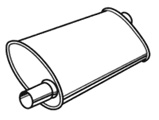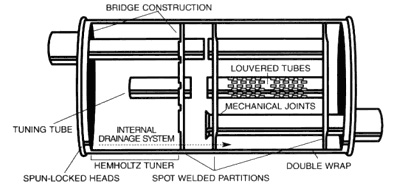How a Muffler is Constructed
All Jeep Vehicles
Introduction
 The muffler is the main source of silencing of exhaust gas noises. It is a combination of tuning chambers, formed by partitions and ventilated and solid tubes. It is designed to effectively contain, absorb and dissipate noise pulses while moving the exhaust gases and vapor smoothly through and ultimately out of the tail pipe. Rock (mineral), wool, fiber-mat, or fiberglass roving placed in the muffler cavities serves to further absorb and eliminate unwanted exhaust sounds. The muffler is the main source of silencing of exhaust gas noises. It is a combination of tuning chambers, formed by partitions and ventilated and solid tubes. It is designed to effectively contain, absorb and dissipate noise pulses while moving the exhaust gases and vapor smoothly through and ultimately out of the tail pipe. Rock (mineral), wool, fiber-mat, or fiberglass roving placed in the muffler cavities serves to further absorb and eliminate unwanted exhaust sounds. The location of a muffler varies considerably depending on the vehicle model, but most mufflers are located toward the rear of the vehicle. Internal muffler design is determined by the "noises" in need of control. The muffler can assume many shapes from round to oval, to custom stamped. To do its job correctly, a muffler must be specifically designed, both inside and out. The inside of the muffler must promote engine performance and sound control, while the outside of the muffler must fit a specific make, model, and year of vehicle. Also, both the inside and outside of the muffler must be able to stand up to the effects of corrosion. As a vehicle's engine runs, it burns anywhere from 1,200 to 15,000 "charges" of air and gasoline per minute. Each time an air and gasoline charge is burned, the engine expels the residual gases into the exhaust system in the form of high-pressure gas. The sound waves created by the high-pressure gas are very powerful. In order to control the sound level of a running engine, the power of these sound waves must be reduced. It is the muffler's responsibility to contain and control the force and noise created by a running engine. In order to do this, the muffler must effectively reduce the pulsations of the exhaust gases, while still permitting the gas to pass freely through and avoid excessive backpressure. Backpressure acts as a brake against the engine, reducing power and performance. |
Inside a Muffler
Internally, a muffler is a combination of chambers, partitions, louvered tubes, and solid tubes. Together, these components are balanced to attenuate sound energy while the exhaust gases are moving efficiently through the muffler. The number and arrangement of the tubes and partitions used in a muffler depends upon the sound frequencies produced by the engine. Some chambers within the muffler have no outlet at all. They are Hemholtz tuners that reduce the low- pitched sound frequencies by providing a cushion for the sound waves. Smaller chambers or pinch cans cancel the high pitched sound waves by channeling exhaust gas through their acoustic openings into larger chambers. The internal structure of a muffler varies between different vehicles because a muffler can be "tuned" to an engine to provide the most effective sound deadening while maintaining performance. To match a muffler to an individual vehicle application may require 30 inches or more of tuning length. If there is only room on the vehicle for 10 inches of muffler, then this tubing must be divided into three 10-inch tubes, resulting in tri-flow routing. A point to note is the more the exhaust gases must be forced to turn and curve, the higher the backpressure created in the muffler. Therefore, the internal design of the muffler is critically important. |
Outside the Muffler
Externally, a muffler must physically conform to the space restriction of the vehicle's underbody. The overall size and shape of a muffler is determined by the size and shape of the available space. Proper design and physical placement is important because of the following reasons:
|
Muffler Construction
Mufflers must be rugged enough to withstand the pulsing vibrations of a high-powered engine, as well as the roughest road shock and the worst enemy of all, corrosion. Some of the major causes of premature muffler failure are the following:
- Rupture from backfires
- Internal corrosion from acid condensate
- External corrosion from chemicals used on icy roads
- Improper suspension support which causes bushing fatigue and fracture
 To protect against rupture, muffler heads are spun-locked to the shell to provide the strongest resistance to backfires. The inner shell and outer cover are also installed 180 degrees apart with a mechanical lock seam. The spun-locked heads and shell lockseam also assure a gas-tight fit between the head and shell.
To protect against rupture, muffler heads are spun-locked to the shell to provide the strongest resistance to backfires. The inner shell and outer cover are also installed 180 degrees apart with a mechanical lock seam. The spun-locked heads and shell lockseam also assure a gas-tight fit between the head and shell.
For every gallon of gasoline burned in the engine, a gallon of acid-bearing vapor passes into the exhaust system. These corrosive acids condense and collect in the bottom of the muffler casing, causing mufflers to rust from the inside out. If all driving was at high speeds on freeways and turnpikes, the internal muffler parts would be kept hot enough to evaporate these corrosive acids, and the inside of the muffler would remain dry. But with stop-and-go driving, the muffler does not get hot enough inside to prevent these acids from condensing and starting corrosion. Mufflers have a number of anti-corrosion features to combat this problem. These include:
- Louvered Tubes - These tubes provide better gas flow to maintain a more uniform internal temperature. By avoiding cool spots within the muffler, most acid condensation can be prevented.
- Internal Drainage System - A complete internal drainage system prevents any acids from collecting between partitions or at the muffler heads.
- Muffler Bushings - Road shock and vibration can cause early muffler bushing breakage. Muffler bushings extend from the head into and through the first internal partition. This two-point bridge contact gives greater structural strength. This is referred to as "bridge construction" and is a good example of the effort that goes into designing a quality muffler.
- Spot Welded Partitions - Spot welding is used to attach the partitions to the muffler shell. This process provides more strength and rigidity than other methods of attachment. Extra partitions are used where additional strength is required.
- Mechanically Joined Internal Tubes - To ensure longer life, internal tubes are mechanically joined to the partition to allow free-floating expansion and contraction during temperature changes. This unique design eliminates the breaking of spot welds and subsequent part distortion or loose part noise problems.
Resonator
|
Courtesy of Walker Exhaust


 The resonator is a second silencing element that is used on some vehicles that have underbody space limitations. When a muffler required to eliminate exhaust noise is too large to easily fit under the vehicle; two smaller silencing elements will then be used. The resonator serves to level out any loudness or roughness, which is not adequately handled by the undersized muffler.
The resonator is a second silencing element that is used on some vehicles that have underbody space limitations. When a muffler required to eliminate exhaust noise is too large to easily fit under the vehicle; two smaller silencing elements will then be used. The resonator serves to level out any loudness or roughness, which is not adequately handled by the undersized muffler.

